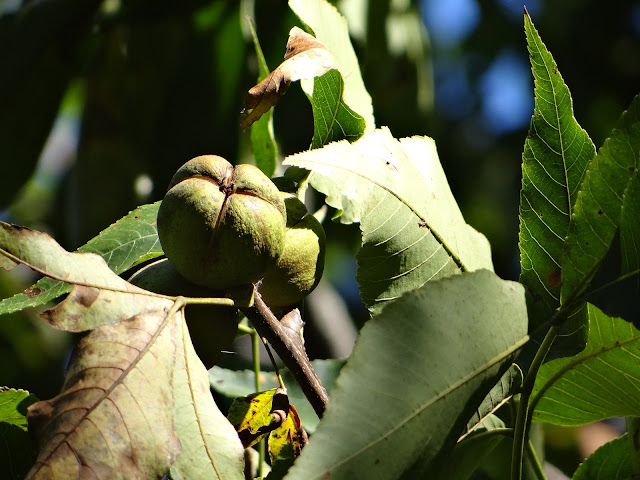 |
Apple, Malus sp.
 |
Shagbark hickory, Carya ovata |
Maturing hickory nuts cause a good deal of
excitement among the squirrels and chipmunks who scramble through the branches
harvesting nuts even before they fall to the ground where turkeys, foxes and
rabbits look for them. Any nuts overlooked by the harvesters from their winter
food caches have a chance of sprouting to generate new trees at some distance
from the parent.
 |
Virginia
Creeper, Parthenocissus quinquefolia |
Virginia Creeper and Catbrier often clamber
together over woody or rocky supports to reach for sunlight. These vines simultaneously
produce dark blue fruit. The combination of Virginia Creeper berries on red
stems against the decorous Catbrier leaves makes a pretty picture, above.
 |
Poison
Ivy, Rhus radicans |
Besides scrambling and rooting
opportunistically, Poison Ivy spreads by producing attractive berries to induce
birds to ingest and disperse its seeds to improbable distant locations.
 |
Virginia
Rose, Rosa virginiana |
Creeping, turf-building native roses utilize similar
methods to Poison Ivy for colonizing the moors of Halibut Point, but have devised
different techniques for self-defense.
 |
Little
Bluestem, Schizachyrium scoparium |
Botanically, a grain of grass is also a
kind of fruit. The fruit wall is very thin and is fused to the seed coat, so
that almost all of the edible grain is actually a seed, making an economical bargain
for dispersal by wind or bird.
 |
Carrion-flower,
Smilax herbacea |
There is a seldom-noticed short, thornless, herbaceous
(non-woody, dies back annually to the ground) version of Cat Brier at Halibut
Point that fruits in remarkable clusters, which is how you're most likely to
find the plant among its robust menacing cousin with almost identical leaves.
It gets its name from a carrion smell given off by the flowers that appeals to
certain insect pollinators.
 |
European
Spindle-tree, Euonymus europaeus |
Before the fruiting capsules of Spindle-trees
open so spectacularly, they closely resemble the model that defines this
otherwise diverse genus represented on Halibut Point by imported Oriental species
Burning Bush (E. alatus), Evergreen
Wintercreeper (E. japonicus), and the
native, less colorful Eastern Spindle-tree (E.
atropurpureus). The plant gets its name from its hard fine-grained wood
that lent itself to carving spindles.
 |
Bittersweet,
Celastrus scandens |
The showy fruit of Bittersweet
(Celastrus scandens)
bear a close resemblance to berries of the above-listed Euonymus, as both are members of the family Celastraceae. This plant of Oriental origins probably gets its name
from opposing characteristics as a rampant invader and a prized ornamental.
 |
Easter
Red Cedar, Juniperus virginiana |
On an interesting botanical note, Juniper berries are
neither true berries nor actually a fruit. Conifers (gymnosperms) in ancient
times evolved a primitive method of reproduction without flowering parts
(angiosperms), which have enclosed ovaries that generate fruit to surround
their seeds. Juniper seeds, like other conifers, are located on the surface of
the cones. They are nevertheless very successful at multiplying their progeny
into the thin-soiled meadows and moors of Halibut Point, often as a
transitional tree to woodlands reclaiming agricultural or industrial areas.
No comments:
Post a Comment